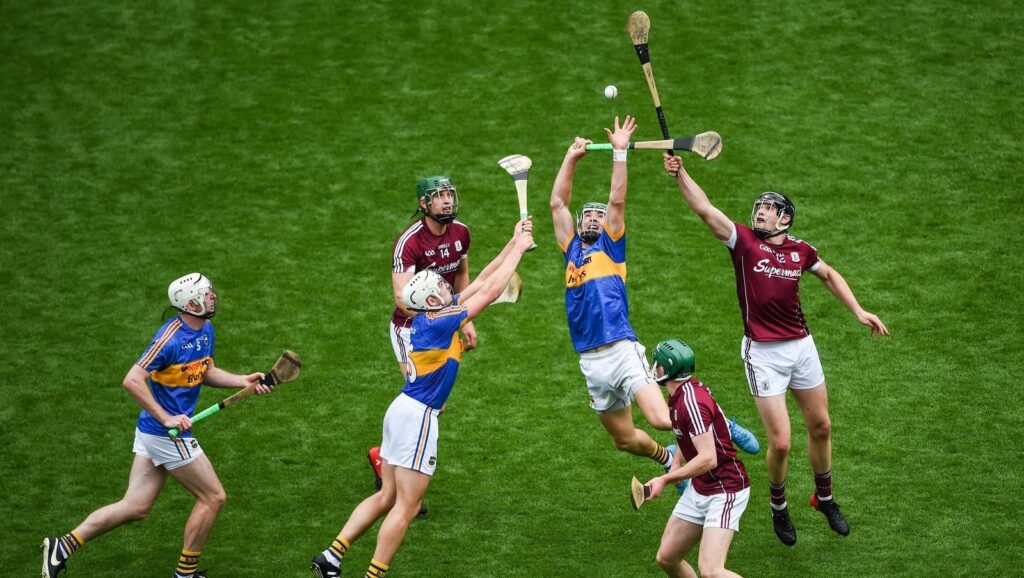What is Hurling Learn More About Playing Hurling
Hurling is an exhilarating and high-speed game deeply rooted in ancient Irish tradition. People widely regard it as one of the most thrilling and demanding sports globally. With a history dating back centuries, hurling offers a one-of-a-kind and adrenaline-pumping experience that is truly unparalleled. Looking for an exhilarating and fast-paced sport to take up? Stop searching because the captivating and intense game of hurling could perfectly fit you.
Two teams of 15 players each play hurling, a traditional Irish game, on a grass field with H-shaped goalposts at both ends. The players use a small ball called a ‘sliotar’ and a wooden stick known as a Hurley or camán in the Irish language. The game involves hitting the sliotar with the Hurley and scoring points by sending the ball between the opponent’s goalposts. It’s an intensely physical and fast-paced sport that is an important part of Irish culture.

In sports that involve throwing, such as basketball, football, and handball. The primary objective is to score points by successfully getting the ball over the bar or into the opponent’s goal. People universally acknowledge that in sports such as basketball and handball, a team earns three points. And they get the points successfully and kick the ball into the net or target. Similarly, in sports like football, this achievement results in the team scoring a goal without any doubt.
By outscoring their opponents with the highest number of points or goals, a team not only secures victory. But also showcases their exceptional athletic abilities and superior strategic prowess. This achievement reflects their dedication to training, disciplined work ethic, and the effective execution of their carefully crafted game plan. It highlights the culmination of their physical and mental preparation. Teamwork their ability to adapt and make split-second decisions under pressure.
Division of Hurling
In the game of hurling, the division of players includes specific positions that each have their own unique roles and responsibilities. These positions are full-back, half-back, midfield, half-forward, and full-forward. The full-back defends the goal, the half-backs stop the opposing team’s attackers, the midfielders play key roles in both defense and attack, the half-forwards support the midfield and attack, and the full-forwards focus on scoring goals and points. Each position requires specific skills and contributes to the overall strategy and success of the team. What is Hurling, learn more about playing Hurling.
- 1 Goalkeeper
- 6 Offensive Players
- 2 Mid-Field Players
- 6 Defensive Players
- 3 Player pairs are matched with their opposite marks.
Hurling association with Ireland
People often regard hurling, a traditional Irish game, as a high-speed sport compared to similar sports like baseball and field hockey. Players use a small, round object called a sliotar, which can reach speeds of up to 180 km/h as they propel it across the field. The players’ remarkable swiftness injects an electrifying sensation of excitement and dynamism into the game, showcasing their incredible athleticism and prowess with dazzling brightness. What is Hurling, learn more about playing Hurling.
Despite these parallels, each sport has its distinct characteristics. For instance, hurling utilizes a small ball called a sliotar and a curved stick called a hurley, while Gaelic football uses a round ball similar to a soccer ball. The rules, terminology, and playing conditions vary significantly between the two sports, leading to distinct identities and creating unique gameplay experiences for participants and spectators alike. What is Hurling, learn more about playing Hurling.
Comparison of hurling sports with Gaelic football. The table shows the complete comparison:
| Characteristic | Hurling sports | Gaelic Football sports |
| Ball type | Sliotar ball: small and hard. | Soccer ball, but is slightly smaller. |
| Objective | Score points by hitting the sliotar over the crossbar (1 point) or into the goal (3 points). | A Player can get/earn by kicking the ball over the crossbar for “1 point” or into the objective for “3 places”. |
| Equipment | Hurley (wooden stick) and sliotar (ball) | None (players use hands and feet) |
| Scoring | Points (over the crossbar) and goals (into the goal) | Points (over the crossbar) and goals (into the goal) |
| Players | 15 players per team (goalkeeper, defenders, midfielders, forwards) | 15 players per team (goalkeeper, defenders, midfielders, forwards) |
| Tackling | Physical, may include blocking, hooking, and side-to-side challenges | Legal physical contact, including shoulder-to-shoulder challenges, blocks, and interceptions |
| Surface for playing | Rectangular field with goalposts and crossbars | Rectangular field with goalposts and crossbars |
| Duration time of Game | Typically, 60–70 minutes | Typically, 60–70 minutes |
| Popular Areas | Ireland, particularly in Gaelic-speaking areas | Ireland and other Gaelic-speaking areas |
| Governing Body | Gaelic Athletic Association (GAA) | Gaelic Athletic Association (GAA) |

History of Hurling sports
Hurling is an incredibly thrilling and fast-paced sport that has been integral to the social fabric of ancient Celtic. Archaeological findings strongly suggest that hurling ranks among the most ancient field sports known to humanity. With roots that reach back to ancient civilizations. Its enduring popularity and deep historical significance have been firmly established. It is a cherished cultural and sporting tradition not only in Ireland but also in various parts of the world.
Hurling is an ancient Irish field game with roots in Gaelic Ireland. It is known for its fast-paced and highly skilled nature, uniquely combining athleticism and finesse. In the sport of hurling, players use a unique wooden stick known as a hurley to strike a small. And leather ball called a sliotar towards the opposing team’s goalpost.”
Hurling is a sport that is intricately woven into the tapestry of Irish tradition and carries immense cultural significance. It serves as a beloved emblem of Irish heritage, captivating spectators with its fast-paced and exhilarating style of play, as well as its deep-rooted history that has been handed down from one generation to the next.
Hurling and Gaelic football share numerous similarities. Players play both sports on a field of typically the same size, with a goal at each end. The primary objective in both sports is to score points by getting the ball into the opposing team’s goal or over the crossbar. In both rugby and Australian rules football, there are 15 players on each team, each with specific positions and roles within the game.
Historic View (1200 BCE)
Hurling is a deeply revered Gaelic sport with a remarkable legacy that spans over 3,000 years. Originating in Ireland, it holds a special place as one of the country’s most cherished traditional sports, embodying the rich cultural heritage and time-honored customs of the nation. This ancient sport boasts a unique and esteemed status in Irish society, symbolizing the resilience and spirit of the Irish people throughout history.
The historical origins of hurling are somewhat obscure due to the lack of written records from its early days. However, it is widely believed that the game has ancient Celtic roots. Strong evidence suggests that a form of hurling was played in Ireland as far back as 1200 BCE, making it one of the oldest recorded games in history. The sport’s rich and ancient heritage is a testament to its enduring popularity and cultural significance.
The unfolding centuries
Throughout the centuries, the ancient sport of hurling has experienced remarkable development, characterized by vibrant communities engaging in impromptu matches across the picturesque landscapes of Ireland. This rich tradition has contributed to the game’s enduring renown, firmly cementing its status as a beloved leisure activity and an indispensable component of Ireland’s cultural legacy.
In ancient times, various geographical regions cultivated their own distinct approaches to sports and games, each characterized by a unique set of rules and practices. The vast array of diversity revealed a multitude of meaningful differences in the manners in which various cultures embraced and engaged in sports and physical activities.
Rules of The Gaelic Athletic Association(GAA)
Hurling is a traditional Gaelic team sport that dates back to ancient times in Ireland. It holds a significant place in Irish cultural heritage and has evolved into a highly organized and fiercely competitive athletic pursuit. The sport brings local communities and clubs together to create teams, and the level of competition is exceptionally intense as they vie for success and triumph over one another.
In 1884, the Gaelic Athletic Association (GAA) played a crucial role in shaping the future of hurling by formally establishing. A comprehensive set of rules that would govern the sport. This pivotal moment marked a significant step in the development and organization of hurling, laying the foundation for the modern game as we know it today. This important advancement was intended to create uniformity in the game and set specific rules for how it is played and conducted.
Spreading and Global Interests
The electrifying speed, skill, and thrill of this particular sport have captivated enthusiasts worldwide, transcending cultural barriers. The sport of hurling has a rich history and holds a unique and widespread appeal. Particularly in regions with vibrant Irish communities. This ancient Gaelic game is deeply rooted in Irish culture and has significant historical and cultural importance.
Hurling quickly gained immense popularity in countries such as the United States, Canada, Australia, and the United Kingdom. It plays a crucial role in its global recognition. International exhibitions further showcased the unique and thrilling aspects of hurling to the world. Which competitions, contribute to the growing global appeal of the sport.
Ireland Senior Hurling as Championship
Ireland highly esteems and widely celebrates hurling, cherished by a passionate and devoted fan community. One cannot deny the All-Ireland Senior Hurling Championship’s status as the pinnacle of competition within the sport. The annual championship is carefully and precisely organized by the Gaelic Athletic Association (GAA), showcasing their steadfast commitment and exceptional skill in managing the event.
When sports teams from different regions come together to participate in competitive events, they are provided with a platform to showcase their skills and talents. This creates an environment where they can engage in friendly rivalries and cultivate a strong sense of sportsmanship. All while striving to ultimately secure the coveted championship title.
Cultural Legacy and Popularity
The ancient and exhilarating sport of hurling has a revered position within Irish culture. Captivating the hearts of both participants and spectators with its intense passion and historical significance. Its ability to evoke excitement and enjoyment only matches its role in uniting communities. The profound cultural impact of hurling stands as a testament to the profound affection. And admiration held for this distinctive and energizing game.
The timeless allure of hurling stems from its deep historical legacy, cultural significance, and fervent zeal. It evokes among participants and spectators alike. The ancient tradition of hurling stands as a powerful symbol of Ireland’s rich heritage and unwavering spirit. Throughout the centuries, this cherished sport has become a symbol of unwavering perseverance, robustness, and rich cultural heritage. It holds great significance for the Irish community, standing as a powerful testament to their enduring and indelible legacy.
